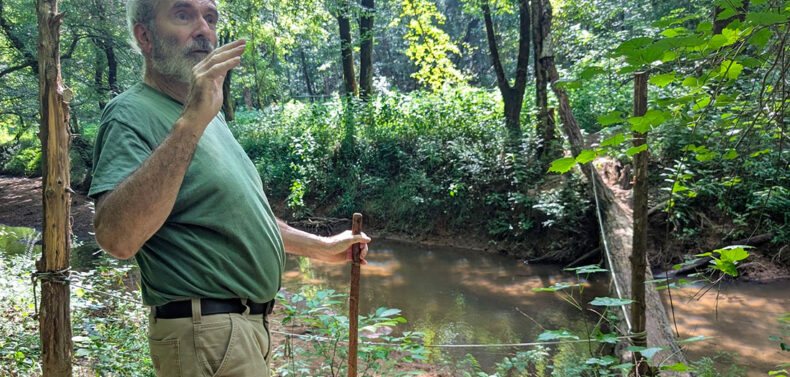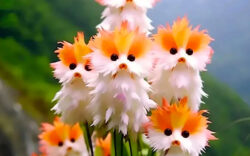Like many of us, John Pickering looked at the neighboring property and thought about what he would do if he owned it. “If I own it, I can kill the bloody privet,” he said.
The property went up for sale in 2019, and Pickering, a retired professor of ecology from the University of Georgia, bought it. That space, along with his original parcel, became the more than 250 acres of greenspace in eastern Clarke County named Shoals Creek Sanctuary.
Pickering set about killing the privet—and other invasives—and experimenting with best practices for fostering a healthy, sustainable forest habitat. This retiree has launched several big projects with community help and hopes the sanctuary can inspire more people to go chemical-free when it comes to their lawns.
“What’s different about this place, we have a massive amount of science out here,” Pickering said. The area is a hub of activity for University of Georgia researchers, as well as citizen scientists and community members interested in learning more about ecology and the environment. Projects range from Atlanta herpetologists documenting the presence of the native eastern newt to UGA’s Warnell School of Forestry monitoring the site’s ash trees.
“We’re running a giant conservation project out here,” said Shoals Creek Sanctuary manager Tyler Lewis.
Pickering hasn’t slacked in the experimentation department either. He spent years taking photos of the moths attracted to the lights outside his home. He was only recently sidelined from his mothing habit after a bad fall off a ladder. Pickering estimates his 15-year collection of moth photos at more than 650,000, and his bird song recordings clock in at more than 1,000 hours. “It’s a very, very healthy forest bird community I’ve got here,” he said.
Pickering’s next big project focuses on encouraging his neighbors, both near and far, to eliminate herbicide and pesticide use on their yards for cosmetic reasons. “This is an immediate problem; we’ve got to get the word out about it,” he said.
Roundup, a popular weed killer, recently switched formulas. Older iterations of Roundup used glyphosate as the active ingredient, a chemical used to kill unwanted plants that’s caused an avalanche of litigation and battling scientific studies over its contested carcinogenic effects.
I, too, have had arguments with people I respect about the use of glyphosate. I’ve seen many people with commercial agricultural chemical training treat glyphosate with wariness and the full-use of protective gear. I’ve also seen the rampant and careless use of glyphosate without gloves and even disregard for the instruction to wash hands after handling a dripping spray bottle.
Users might not have noticed that the active ingredients in many Roundup products changed during the last year. Several of the replacement active ingredients raise toxicity concerns in other countries. For example, diquat is banned in the European Union and China, but is legal in America and an active ingredient in some new Roundup formulas. Commercial applications of Roundup continue to use glyphosate.
Pickering’s solution is to change attitudes toward yards. He wants people to ignore weeds and request no-chemical treatments from their lawn services. He wants people to plant native species and remove invasives without relying on herbicides. “The goal is to show people you can manage invasives without chemicals,” he said.
Reintroducing native plants has had a steeper learning curve than removing the privet or installing fences to exclude deer. Pickering said he’s had no luck with broadcasting seed. Instead, he buys large orders from the State Botanical Garden of Georgia’s plant sales and germinates his own seeds to plant in the sanctuary.
If you’re interested in planting more natives for pollinators, I’d suggest trying broadcasting yourself. It’s a technique I’ve used successfully multiple times to plant rye grass and vetch for Bermuda grass control in the garden. I’ve also used it to establish wildflower patches on my property. If you’re looking for more information about planting a garden by broadcasting, I like American Meadows’ seed mixes and instructions.
Shoals Creek Sanctuary is a beautiful area, and if you’re interested in learning more about Georgia’s native ecosystem—or how to manage invasives like privet, yellow flag iris and others—it’s a good place to spend some volunteering hours. For more about Shoals Creek Sanctuary, visit shoalcreeksanctuary.org. If you’d like to learn more about mothing in particular, visit discoverlife.org/moth.
Like what you just read? Support Flagpole by making a donation today. Every dollar you give helps fund our ongoing mission to provide Athens with quality, independent journalism.









